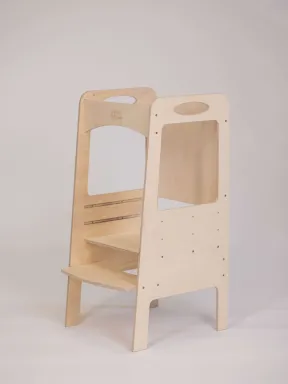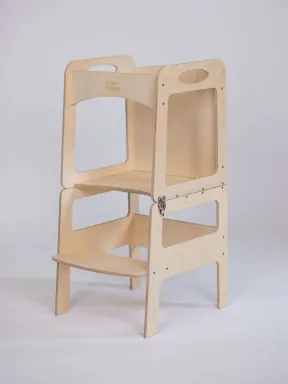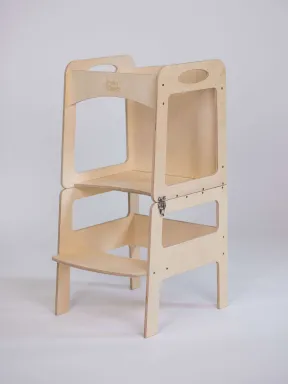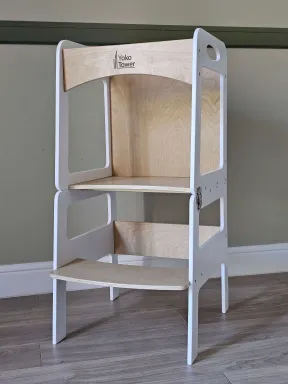- Learning Tower
- 1 likes
- 2494 views
- 0 comments
- learning tower, Montessori tower, transformable tower, adjustable tower

Differences Between Lacquered Montessori Tower and Natural Color: A Guide to Choosing the Best
When choosing a Montessori tower made from birch plywood, you often find yourself deciding between two main options: a clear lacquer finish and a natural color finish without any coating. In this article, we will explore in detail the differences between these two options, helping you make the right choice for your child.
1. Surface Texture
Lacquered natural-colored towers have a slightly rough surface to the touch. This happens because during the application of the lacquer, the birch fibers rise slightly due to the lacquer’s texture. This texture can offer a more tactile and grippy feel. On the other hand, birch towers with a natural, untreated finish are extremely smooth and soft to the touch, thanks to careful sanding that keeps the surface free of imperfections.
2. Color and Appearance
Another noticeable difference between the two finishes is the color. Lacquered towers tend to develop a slight yellowish tone due to the coating, which adds warmth to the natural color of the birch. This effect is very subtle but gives the product a warmer, more classic appearance. In contrast, untreated towers retain the original color of birch, which is lighter and more natural, offering a minimalist and modern look, perfect for those who prefer a purer and more authentic aesthetic.
3. Moisture Resistance
Moisture resistance is a crucial factor to consider. Lacquered natural-colored towers are highly resistant to moisture, thanks to the protective layer of lacquer that prevents the wood from absorbing water or other liquids. This makes them particularly suitable for use in environments where they might come into contact with liquids or be prone to staining. Conversely, untreated towers are more porous and can absorb moisture, making them less resistant to stains and water damage.
4. Maintenance and Durability
A significant advantage of untreated towers is their ease of maintenance. If the surface gets stained or worn over time, it can be easily sanded with 180-grit sandpaper, allowing you to renew the appearance of the tower without needing complex or expensive treatments. Lacquered towers, while more resistant to dirt, cannot be sanded without removing the protective finish, which can complicate long-term maintenance.
Choosing between a lacquered natural color Montessori tower and a natural color one depends on your preferences and your child's needs. If you are looking for a surface that is more resistant to moisture and easier to clean, the lacquered version might be the ideal choice. On the other hand, if you appreciate a more natural look and want the option of easy maintenance at home, the natural color tower may be right for you. With YokoTower, whichever choice you make, you are assured of getting a high-quality product designed to last and support your child's growth.









